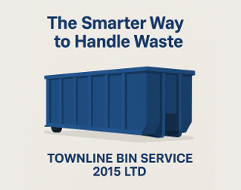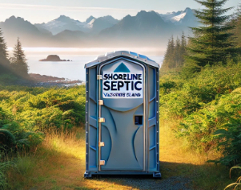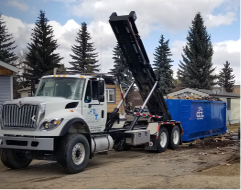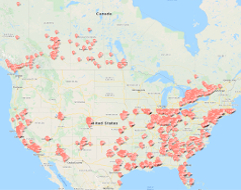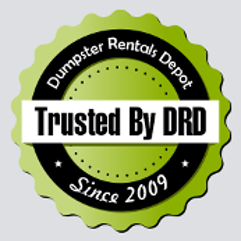Dealing With Glass Waste

If you think that glass is a neutral substance and the glass waste doesn't pollute the environment, think again. Keep reading to learn how folks in Europe work together to address glass waste related issues.
At Dumpster Rentals Depot we are always open to learning about best practices in the Waste Management Industries worldwide. We continuously look for opportunities to work with external partners such as environmentally concerned organizations, businesses, and institutions to access different pools of knowledge and learn about their experience with addressing waste management related issues. Universities are among the external partners that offer high promise since they allow access to an enormous pool of talent and skills.
Pursuing collaboration with university researchers we recently established ties with folks at the Geographical faculty of the State University in Kiev, Ukraine who kindly allowed us to reprint one of their articles that illuminates a mutual effort of several European countries to reduce a negative impact of glass waste. We reprint the article as is.
International cooperation for building sustainable landscape of Baltic Sea catchment
V. Mykhaylenko, W. Hogland, M. Hogland, Y. Jani, F. Kaczala, M. Kriipsalu, J. Burlakovs, G. Denafas, M. Grodzinsky
Taras Shevchenko National University of Kyiv, Ukraine,
Linnaeus University, Sweden,
Estonian University of Life Sciences, Estonia,
Geo IT Ltd, Latvia,
Kaunas University of Technology, Lithuania
The international project entitled “Phytoremediation Park for treatment and recreation at glassworks contaminated sites” aimed at shaping rural sustainable landscapes in the Baltic Sea catchment. Sweden, Estonia, Latvia and Ukraine have intentions to share best available practice experiences to clean-up landscapes deteriorated by old glassworks dumps. Sweden is on the way to clean-up more than 40 sites from the Kingdom of Crystal Glass, Estonia and Latvia have mapped the information and contaminated sites are on the priority lists for future clean-up actions. The majority of 74 intensively operated glassworks in Ukraine are already closed and expected to have the revitalization in future. These facts obligated to raise public awareness and provide inventories of glass dumps to make sustainable landscapes viable.
Introduction. Generation of waste has become an increasingly global problem due to the urban population growth, augmented consumption and, as a result, production of excessive waste that increases negative impact to nature and human health. International environmentally sound cooperation intends to relief negative consequences of landscape pollution. The European Landscape Convention (ELK), Party of which is Ukraine, provides an effective mechanism aimed at the remediation of injured lands. This paper aims to put the landscape protection values at the spot line of land rehabilitation policy in the framework of international cooperation and socio-economic considerations.
The term “landscape” is not an easy one to understand it clearly, even if it is used to explain the sight right in front of us. The ELC tells that „landscape is an area as perceived by people, whose character is the result of the action and interaction of natural and/or human factor”. The modern geographical approach is to include in “landscape” all the elements interacting in the distinct geographical element would it be soil, biota, climate or industrial activities performed by humans. It means that perception in the frame of this definition has large importance in reflection, feelings and imagination, as well as – the perception has impact from social and cultural aspects of society and individuals.
The most successful landscape policies in Western Europe are those with strategies at all levels of administration, from national to local levels that are clearly linked and known as Triple Helix Cooperation that provides consistency to the system as a whole. The main goal of the EU Strategy for the Baltic Sea Region (BSR), established in 2009, is to restore the good ecological status of the Baltic Marine ecosystem by 2021 and to move the region towards a sustainable development and prosperity. To achieve these goals, the creation of cross-sector partnerships (Triple Helix) within different countries in the Baltic Sea catchment in diverse levels of the society is the promising strategy. The Triple Helix model introduced itself as a valid social-economic mechanism to drive structural changes far beyond the scope that any organization could achieve on its own.
The Environmental Science & Engineering Group (ESEG) at Linnaeus University, Sweden, has been investigating closing the landfill life cycle (landfill mining) together with researchers from different Baltic countries since 2012. Nowadays ESEG is leading the project entitled “Phytoremediation Park for treatment and recreation at glassworks contaminated sites” (PHYTECO) that started in August 2015. The main goal of the project is strengthening a sustainable collaboration with experienced partners within the Baltic Sea countries and introducing the establishment of phytoremediation touristic parks as a rehabilitation step for the contaminated sites. It aims at cross-sector international partnership with the pull of stakeholders included local government and business organizations, universities, glassmakers’ artists from Sweden, Estonia, Latvia and Ukraine and is supported by the Swedish Institute.
More than 40 old glassworks are located at the Kingdom of Crystal, Småland, Sweden. There are 10 among 22 glassworks locations possessed acute risks and danger to the environment and human health. Although glass is commonly regarded as inert, glass waste usually contains significant amounts of toxic additives. According to the County administrative boards in Kalmar and Växjö, the glassworks in Småland region contain an estimated 310 tons of arsenic, 19 tons of cadmium, 1600 tons of lead and with large volumes of glass waste (>130 000 m3). This is a typical problem caused by old landfills surrounded at the Baltic Sea catchment. Estonia had more than 360 landfills, which are all closed and covered by now. The national policy since early 2000-s was to close all previous dumpsites and landfills because none of them met environmental standards. There are slightly above 260 historical contaminated sites in Latvia and around 30% of them are dumps and landfills. From all contaminated sites mentioned in Priority List, 56 of them contain multicomponent contamination of heavy metals (including combined pollution with organic substances). List of contaminated sites does not have any information on historical pollution caused by glass factories, however, it is known that some of the historical industrial dumps might contain a large portion of glass waste and additionally two sites are known from the former Soviet period when glass industry was of high importance. Nevertheless, even from chronicles of the 17th century when Kurzeme (Kurland) was developed as an independent aristocracy state with developed glass industry, it is possible to find contaminated sites of archaeological importance dissipated in large distinct areas. There are 6,000 dumps and landfills in Ukraine, of which 3,049 have not been certified yet. High remediation costs (more than 119 million USD) in a conventional “dig-and-dump” approach means that the remediation of these sites has to be carefully prioritized.
Ukrainian context. Only few people realize that Ukraine, which has no waterfront with the Baltic Sea, has much more impact on the quality of Baltic Sea environment than for instance Estonia with its 780 km of maritime boundary. The tributary to the Western Bug that belongs to the Baltic Sea basin is much polluted by the Poltva River. It carries drainage water from the landfill “Zbyranka” of Lviv city where 735,000 people live. “Zbyranka” contains 8.4 million tons of waste and was included in a list of 100 most ecologically dangerous sites in Ukraine. Concerning glass dumps in Ukraine, the situation is similar to Swedish. At present, 59 of 74 glassworks that operated successfully during Soviet times are closed. In general, the current practice of waste management in Ukraine does not ensure protection of the environment and human health from harmful impact. The profile Ministry is reporting about of 35,000 illegal dumping places corresponding to approximately 4,2% of the territory.
Aiming sustainable solutions. Glass dumps and municipal solid waste (MSW) landfills contain a lot of valuable resources that can be recovered and utilized. The estimated content of glass cullet in landfilled in Ukraine varies from 5% up to 9 % of total content. For these reasons, it is essential to establish safe and cost-effective methods for excavation of valuable materials and transformation of old landfills. Collaborative planning poses an unstructured problem to practitioners and scientists: the objectives of landscape change and how to accomplish them are not defined at the start of the process and the required knowledge is uncertain. For such unstructured problems, the literature recommends a transdisciplinary approach in which several scientific disciplines work together with regional actors.
Closing the Life Cycle of Landfills - Landfill Mining (LFM) is one of the Linnaeus university initiatives. In principle, LFM refers to the excavation, processing, treatment and recovery of deposited materials situated in informal waste dumps and in structured landfills. Phytoremediation technique, which is a green and a low-cost technique used for the remediation of soil by using plants that have the ability to uptake heavy metals from soil and save it in the plants roots and shoots, has been widely and successfully used to treat and rehabilitee large contaminated areas in different countries, although longer treatment time is required. The phytoremediation technique can be a good solution for the rehabilitation of the glassworks sites before or after excavation if the plan for such project is investigated and prepared well. The phytoremediation technique for establishing Recreation Park was applied at Kudjape landfill, Estonia as a rehabilitation step after excavation of solid waste. The same idea is suggested to be useful to rehabilitee the Boda glasswork in Emmaboda town, Sweden. The results of phytoremediation implementation may be attractive to citizens and decision makers because it is friendly to nature, less expensive, allows maintaining and improving ecosystem, provides aesthetic values and allows taking site-specific solutions.
Glass recycling is a special thing. Although it is a relatively cheap material, considerable energy is needed for its production, and its cost is constantly growing. Recycling glass reduces energy use by up to 30 %, while air 20%, and half reduce pollution as much water is used. Glass is a perfect example of what we call a ‘circular economy’ ensuring that all the pre-existing benefits of glass come back to be used once again bringing profit to the companies at the same time that contribute to a cleaner environment. The PHYTECO project may broaden understanding of glass market, resources of buried and wasted glass materials and also how to overcome the existing challenges to decontaminate glasses from metals in a way that both metals and the glass itself can be recovered and used without major environmental and human health problems. It also may evaluate potential glasswork needs in recycled incomes and identify the needs for creation and realization of investment projects that deals with secondary glass resources. Communicating with the business companies may show the ability to use secondary materials as resources and making benefits on the long term perspective of glass mining and even municipal landfill mining that contains up to 9% of secondary glass. Conclusions. The landscape of today reflects the way society has taken care of it. The quality of the landscape affects the quality of everyday life of citizens. The only way to create sustainable landscapes is to identify our preferences for managing, planning and protection of landscapes in Europe. It needs an adequate landscape policy that establishes general principles, strategies and guidelines aimed at the protection, management and planning of landscapes.
The overall aim of PHYTECO is to contribute to harmonization of policies of BSR in the field of closed glassworks relieve management. The project team will work to achieve common understanding of the terms ‘landscape’ ‘glass mining’ and ‘phytoremediation’, and to elaborate regional criteria for identification and prioritization of glass landfill remediation around closed glassworks in the region. The specific aims are to contribute to increasing public awareness and wider involvement of local authorities and local population of the BSR in the decision-making on guiding sustainable landscapes.
Lack of landscape policy in Ukraine slows down the processes of landscape recovery and it is not conducive to restoring contaminated areas. Among Ukrainian priorities, the recognition of ELC importance that positioned landscape as an essential component of people's surroundings in law is included. Defining of National landscape policy and its implementation at the national and local levels, aimed at ensuring the protection of the European landscape, its management and planning should be one of Ukrainian priority. We also realize that education and training with special reference to the landscape issue are crucial to whatever improvement of the landscape management and sustainable landscape we want to achieve.
This project will also be an opportunity of scientific development between all the Baltic Sea countries through knowledge and experience exchange among all the involved partners. International cooperation will support Ukraine to develop its own strategies on sustainable landscape management and assumptions about the effect of waste glass, contaminated glassworks sites and profitable ways to eliminate risks from glass landfills on cultural landscapes.
Acknowledgment. The international collaboration was supported by the Swedish Institute.
References
1. European Landscape Convention of the Council of Europe, Ch. I, Article 1a.
2. Tress, B., & Tress, G. Capitalizing on multiplicity: A transdisciplinary systems approach to landscape research. Landscape and Urban Planning, #57, 2001, pp. 143–157.
3. Muir, R. Approaches to landscape. Houndmillis: Mcamillan Press OED (Oxford English Dictionary Online), 1989. Oxford University Press, Oxford. http://www.oed.com
4. Etzkowitz, H. The Triple Helix: University-Industry-Government Innovation In Action. London: Routledge, 2008. Translated into Russian (2010).
5. Hogland M., Hogland W., Jani Y. et al. Experiences of Three Landfill Mining Projects in the Baltic Sea Area – with focus on machinery for material recovery. Conf. proc., Linnaeus ECO-TECH´14, Kalmar, Sweden November 24-26, 2014.
6. PHYTECO project regenerates glassworks site. Swedish Institute (2015). Available at: https://eng.si.se/phyteco-project-regenerates-glassworks-site/
7. Landfills yield environmental benefits. Swedish Institute. Available at: https://eng.si.se/landfills-yield-environmental-benefits/
8. Andersson, S., 2012. "Glasburkens historiska miljöskuld". Länsstyrelsen i Kalmar Ian (in Swedish)
9. Ministry of Housing of Ukraine, Analysis of municipal waste treatment in Ukraine in 2012 (official Report of 11.04.2013, in Ukrainian); Available at http://www.minregion.gov.ua/zhkh/Blahoustri-terytoriy/stan-sferi-povodzhennja-z-pobutovimi-vidhodami-v-ukraini-za-2012-rik/
10. Global International Waters Assessment Baltic Sea, GIWA Regional assessment 17. UNEP, 2005. Available at: http://www.unep.org/dewa/giwa/areas/reports/r17/giwa_regional_assessment_17.pdf
11. Popovych O.R. Yarema O.R. Problems of MSW and Industrial Waste Utilisation in Lviv Oblast (in Ukrainian) Ed. Lvivska Polytechnica #609, 2008 Available at http://vlp.com.ua/files/64_4.pdf
12. Pohribnyy I. Identification of MSW morphology, in view of current processing conditions. Effective recycling economy №11, 2012 (in Ukrainian) Available at: http://www.economy.nayka.com.ua/?op=1&z=1527
13. Termorshuizen J. Opdam P. Landscape services as a bridge between landscape ecology and sustainable development. Landscape Ecol., #24, 2009, pp.1037-1052.
14. Bhatnagar A., Kaczala F., Kriipsalu M., et al. Closing the Life Cycle of Landfills - Landfill Mining in the Baltic Sea Region for future. Proc. of Linnaeus EcoTech- 2012. Nov. 26-28, 2012, Kalmar, Sweden, pp 26-28.
15. Stenis J., Hogland W., Economic Optimization of Urban Mining. Iranica Journal of Energy & Environment, #5 (4): 2014, pp. 337-344.
16. Hogland W., Marques M., Nimmermark S., Landfill mining and waste characterization: A strategy for remediation of contaminated areas, Journal of Material Cycles and Waste Management, #6, 2004, pp. 119-124.
17. Hogland W., Remediation of an Old Landfill Site – Soil Analysis, Leachate Quality and Gas Production, Environmental Science and Pollution Research, Spec # 1, 2002, pp. 49-54.
18. Savage, G.M., Golueke, C.G., von Stein, E.L. Landfill mining: Past and present. Biocycle #34, 1993, pp.58-61
19. Rai U.N., Toxic Metals and Phytoremediation. EnviroNews - Newsletter of ISEB India Vol. 5 No. 4 – Oct. 1999. Available at: http://isebindia.com/95_99/99-10-2.html
20. Landscape and sustainable development Challenges of the European Landscape Convention. Council of Europe publ., July 2006, - 216 p.
- Published: 2017-04-25T15:20:18-07:00
- Author: Laura Schmidt, Dumpster Rentals Customer Supp
